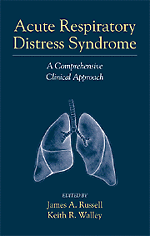Book contents
- Frontmatter
- Contributors
- Contents
- Preface
- Introduction
- 1 Overview, Clinical Evaluation, and Chest Radiology of ARDS
- 2 The Epidemiology of ARDS
- 3 The Pathology of ARDS
- 4 Cytokine -Induced Mechanisms of Acute Lung Injury Leading to ARDS
- 5 Pulmonary Pathophysiohgy in ARDS
- 6 Cardiovascular Management of ARDS
- 7 Mechanical Ventilation
- 8 Respiratory Muscles and Liberation from Mechanical Ventilation
- 9 Clinical Assessment and Total Patient Care
- 10 ARDS: Innovative Therapy
- 11 Nosocomial Pneumonia in ARDS
- 12 Resolution and Repair of Acute Lung Injury
- 13 Multiple System Organ Failure
- 14 Outcome and Long-Term Care of ARDS
- Index
10 - ARDS: Innovative Therapy
Published online by Cambridge University Press: 05 October 2010
- Frontmatter
- Contributors
- Contents
- Preface
- Introduction
- 1 Overview, Clinical Evaluation, and Chest Radiology of ARDS
- 2 The Epidemiology of ARDS
- 3 The Pathology of ARDS
- 4 Cytokine -Induced Mechanisms of Acute Lung Injury Leading to ARDS
- 5 Pulmonary Pathophysiohgy in ARDS
- 6 Cardiovascular Management of ARDS
- 7 Mechanical Ventilation
- 8 Respiratory Muscles and Liberation from Mechanical Ventilation
- 9 Clinical Assessment and Total Patient Care
- 10 ARDS: Innovative Therapy
- 11 Nosocomial Pneumonia in ARDS
- 12 Resolution and Repair of Acute Lung Injury
- 13 Multiple System Organ Failure
- 14 Outcome and Long-Term Care of ARDS
- Index
Summary
Introduction
The search for new therapeutic approaches in ARDS has multiple motivations. First, and foremost, is the persistently high mortality associated with current clinical management which ranges from 35% to 80%. Second, a plethora of mediators have been described, as discussed elsewhere in this text, that may be responsible for or significantly contribute to ARDS. Recently a wide variety of seemingly innocuous agents have been identified and purified that have been shown in vitro or in animal models to be able to block the effects of many of the putative mediators of the syndrome. What follows is a discussion of the pharmacologic agents that have received the most attention for their potential to reduce the incidence, severity, or duration of ARDS.
Surfactant Replacement
When washed clean of surfactant, the alveolar surface of the lung develops a marked increase in surface tension, which causes the lung to become very noncompliant and collapse at low transpulmonary pressure. Surfactant is a naturally occurring complex of phospholipids, neutral lipids, and several specific proteins that is secreted by type II pneumocytes. The clinical model of pure surfactant deficiency is infant respiratory distress syndrome, IRDS. This process is similar to ARDS, but little or no evidence indicates that surfactant abnormalities are fundamentally pathogenetic in ARDS (as they are in IRDS).
The pressure-volume behavior of the diseased lungs with ARDS has been clearly associated with surfactant depletion/dysfunction. The surfactant lavaged from ARDS patients functions poorly and is of abnormal composition. Native surfactant is impaired by inflammatory substances released by activated granulocytes and is inactivated simply by mixing with pulmonary edema fluid.
- Type
- Chapter
- Information
- Acute Respiratory Distress SyndromeA Comprehensive Clinical Approach, pp. 233 - 250Publisher: Cambridge University PressPrint publication year: 1999
- 1
- Cited by

